A Guest Post From:
Cliff Fowler
Raising backyard chickens is becoming more and more popular these days. And why shouldn’t it, after all, they provide an endless supply of food if bred periodically. But, what do you do when a hen stops laying? Or, what do you do with those roosters that hatch out every now and again?
Sure, that cock-a-doodle-do at the crack of dawn can seem like peaceful life on a farm, but if you’re not going to use those roosters for breeding, then they will have to be culled.
They can be sold to make an extra buck, or you can just throw them in a pot. It may sound like a daunting task, but processing chickens is not that hard to do if you have the right tools, a decent workstation, and the stomach for it.
Tools for the job:
- Good sharp knife
- Bone scissors
- Pot of boiled water
- Ice chest full of ice
- Propane torch
- Axe, hatchet, or machete
- Good chopping block
Make sure you have all your tools ready at your workstation because this is a process that you’ll want to quickly finish.
The first thing you’ll want to do is pick out the rooster or hen that you want to cull. You’ll want them to be no older than a year, preferably six to eight months with roosters, but hens that have stopped laying will be beyond this point.
The younger the better for roosters because once they get over this age the meat will not be as tender. I like my chicken tender and juicy, so here’s the one I chose to process. Ain’t he a beauty?
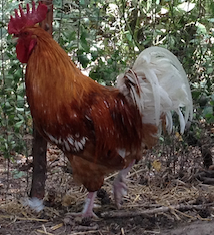
At this time you’ll want to start your pot of water to boil. The pot needs to be big enough to submerge the entire chicken. Wetting the feathers in hot water will make plucking them a lot easier. It will take a few minutes for water to boil; so you’ll need it boiled about the same time your chicken/rooster gets done flopping around after the kill.
Ever hear the phase “running around like a chicken with your head cut off?” They don’t actually run around without their head, but they will flop around. This is what they do no matter how you kill them, but it’ll only last a minute or two.
How you choose to do the deed is up to you. I like using a .22 rifle shot to the head. It just seems like the easiest way, and it’s more fun. Make sure the shot is to the head; you don’t want a body shot and spoil the meat. If you’re not that great of a shot, then you can lay his head across a chopping block while holding it by the legs.
Take a sharp axe or machete and remove the head. This method is probably the messiest because of the blood that will be slung all over while it’s doing the floppy dance, unless you manage to not let go of it.
Here’s the pot I’ll be using for my bird…
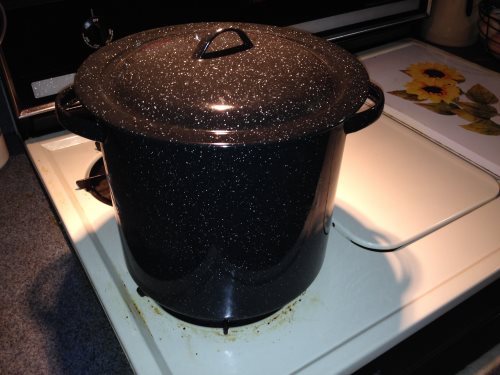
After the chicken stops kickin, dunk it in the pot of boiled water. You’ll only want to submerge the bird just long enough to get the feathers wet, no more than thirty seconds. Move the bird up and down in the water to make sure all the feathers get wet.
If you leave it in the hot water too long it will begin to cook, and you do NOT want this.
After the dunk in hot water, hang it by its feet at a comfortable level to work with. You can use twine to do this, or have someone hold it by the legs while you start plucking. You can also hold it in one hand while plucking with the other. At this time you’ll notice how easy the feathers are to remove and you should make short work of it in no time at all.
The small pinfeathers are the hardest to remove. They come out most easily under a stream of cool water. You may rub them out and finish removing the more difficult ones with a dull knife against your thumb.
If the bird has hair, singe them with the propane torch, directing the flame parallel to the skin, and pass over them quickly as you don’t want to hold the flame in one spot for too long or the bird will begin to cook.
Here’s mine after the feathers are gone…
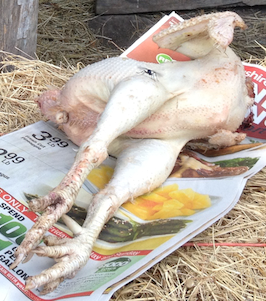
There is an oil gland on the tail of the carcass that you will want to remove. I never use the tail, so I just cut the entire tail off. There are, however, uses for the tail and neck. For example, if you have pets, they make great treats for them after they are cooked. You will want to cook them before feeding it to your pet to ensure that your pets do not become chicken murderers, or consume any unhealthy microorganisms.
To remove the head, if you have not done so already, locate any joint on the neck that is suitable to you, and using the bone scissors snip in two. You should properly discard any unused parts, including feathers.
If you are unfamiliar with bone scissors, here’s a picture of the ones I’ll be using…
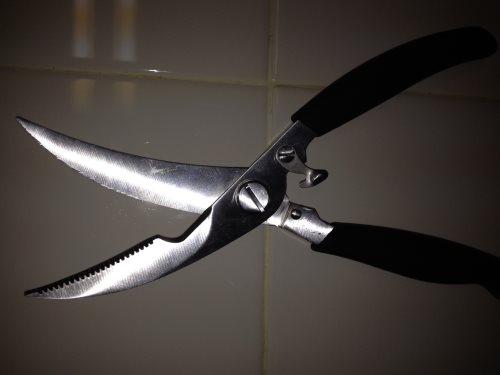
The location of the oil gland is on the topside of the tail, included in the diagram below. To remove it, cut in front of the nipple of the oil sack toward the rear, and scoop it out as you cut.
You can, however, remove the entire tail if you’re not intending on using it. This can be done with your knife, and they are fairly easy to remove.
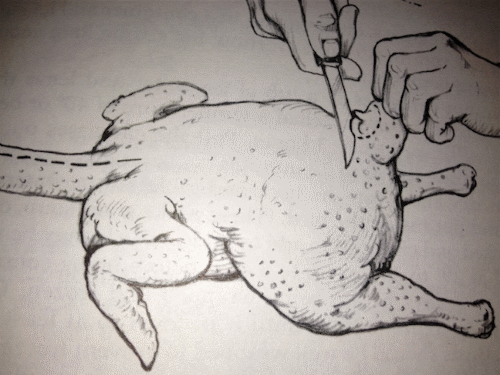
To prepare the carcass for eviscerating, make a cut under the rear end of the breastbone down to the tail and anus. Cut around the anus as shown in the picture below, and remove the insides with your hand.
Once disemboweled, you may choose to keep the heart and gizzard. Hearts make great fish bait. You will want to cut the gizzard open under flowing water and wash it thoroughly.
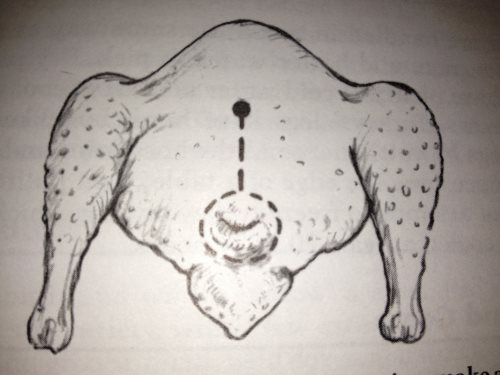
After this step, you will remove the feet. Make a cut along the joint of a leg and foot and break them backwards, then finish the cut with your knife. Your bird will be finished after this step and ready for the ice chest. The chest of ice will cool the bird. It is best to leave the bird in the ice chest for approximately three to four hours. This will ensure there will be no gamy taste to it.
Afterwards, put it in a pot, freeze it whole, or cut it to your liking. For instructions on how to cut up a chicken, refer to Google.
Here’s a picture of my finished product…
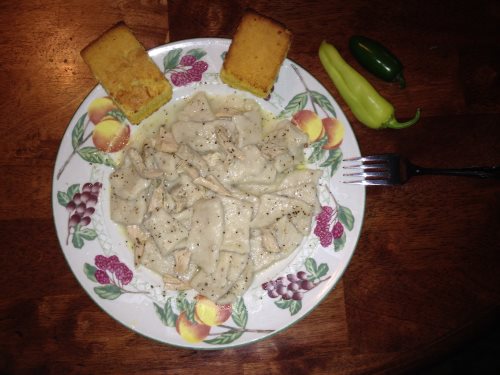
mmm, mmm, good!
Discover more from Survivalist Prepper
Subscribe to get the latest posts sent to your email.
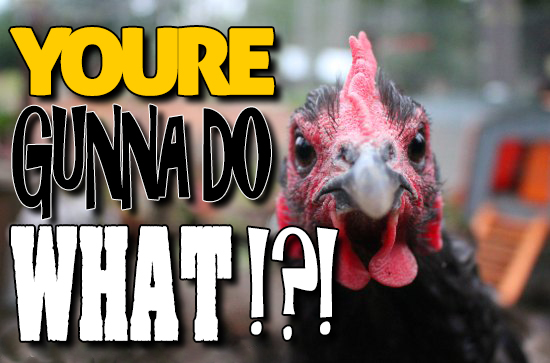
1 Response to "Duck Processing: Too Many Cock-A-Doodle-Dos"
My mom taught me never to give pets cooked bones (especially poultry) because they are prone to splintering resulting in a risk for internal injury.